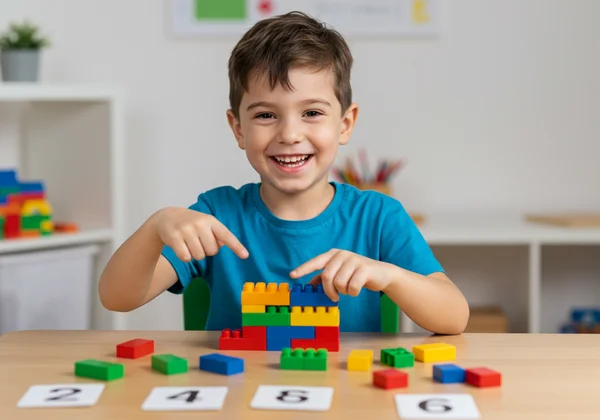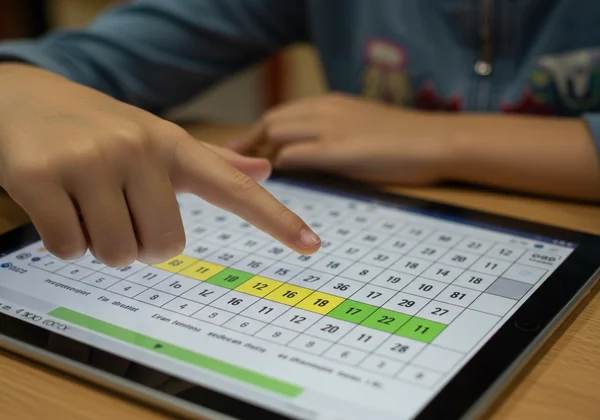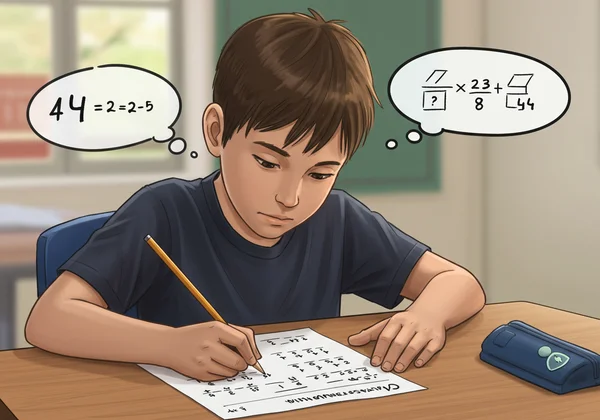Master Multiplication with Interactive Charts: A Grade-by-Grade Guide for Ages 7-10
Watching a child learn multiplication can feel like watching them unlock a new level in their understanding of the world. But for many parents and teachers, this crucial stage can be challenging. You might wonder, how can I help my child learn multiplication? The key is to introduce concepts at the right pace, using methods that match their developmental stage. This guide provides a clear, grade-by-grade roadmap for teaching multiplication to children aged 7 to 10, turning potential frustration into a journey of discovery.
This journey is about more than just memorization; it's about building a deep understanding of numbers. With the right strategies and tools, like an interactive times table , you can make learning multiplication an engaging and rewarding experience for every child.
Starting Strong: Multiplication for 2nd Graders (Ages 7-8)
For second graders, multiplication is a brand-new adventure. The goal at this stage isn't mastery but a gentle and fun introduction to the core concepts. The focus should be on understanding what multiplication is—repeated addition—before moving on to memorizing facts.
Introducing Basic Concepts & "Skip Counting"
Before you even mention the word "times," you can lay the groundwork with skip counting. This is one of the most intuitive ways for a child to grasp multiplication. Start by counting by 2s (2, 4, 6, 8), 5s (5, 10, 15, 20), and 10s (10, 20, 30, 40). Use physical objects like blocks or coins to make it tangible. For example, create five groups of two blocks and count them together to show that 5 groups of 2 equals 10. This hands-on approach directly illustrates that 5 x 2 is the same as 2 + 2 + 2 + 2 + 2.

Essential Times Tables for Grade 2: The Building Blocks (0, 1, 2, 5, 10)
Rushing to learn all the times tables at once is a recipe for overwhelm. In second grade, focus on the easiest and most foundational tables. These are the building blocks that will make learning the harder tables much simpler later on.
- The 0s Table: The "zero rule" is simple and empowering. Anything multiplied by 0 is 0.
- The 1s Table: The "identity rule" is just as easy. Any number multiplied by 1 is itself.
- The 10s Table: This table has a fun and easy pattern. Just add a zero to the end of the number you are multiplying by 10 (e.g., 10 x 4 = 40).
- The 2s Table: This is simply doubling a number, which connects to addition facts they already know (e.g., 2 x 3 is the same as 3 + 3).
- The 5s Table: This table has a clear pattern, with answers always ending in 0 or 5.
Fun & Interactive Grade 2 Multiplication Activities
At this age, learning must be playful. Use an online multiplication chart to visually explore these first tables. The color-highlighting feature can make patterns pop, helping kids see how numbers relate. You can also use flashcards, sing multiplication songs, or play simple games like "Multiplication War" with a deck of cards. The goal is positive exposure and building confidence.
Building Fluency: Mastering 3rd Grade Multiplication (Ages 8-9)
Third grade is where multiplication takes center stage. The focus shifts from introduction to fluency. Students are expected to memorize most of the times tables up to 10x10 or even 12x12. This is the year to build speed, accuracy, and a solid foundation for future math success.
Expanding Times Tables: Up to 12x12 & Beyond
With the 0s, 1s, 2s, 5s, and 10s mastered, you can now tackle the remaining tables. Introduce them systematically:
- The 3s and 4s: These can be learned through skip counting and recognizing patterns.
- The 9s: The 9s table has a famous "finger trick" and a cool pattern where the digits of the answer always add up to 9 (e.g., 9 x 3 = 27, and 2 + 7 = 9).
- The Tricky Tables (6s, 7s, 8s): These are often the hardest. By this point, however, a child already knows many of the facts from other tables (e.g., they learned 6 x 2 when they learned the 2s table). Focus on the few remaining new facts.
Effective Strategies for Memorization & Recall
Rote memorization alone can be tedious. Combine it with strategies that deepen understanding. The commutative property (knowing that 3 x 7 is the same as 7 x 3) effectively cuts the number of facts to memorize in half. Use mnemonic devices, rhymes, and stories to make trickier facts stick. Consistent, short bursts of practice are far more effective than long, infrequent cramming sessions.
Leveraging Interactive Charts & Printable Multiplication Resources
This is the perfect stage to lean heavily on powerful learning aids. An interactive multiplication table is an incredible tool for exploration. Students can click on any problem and see the answer instantly, providing immediate feedback. They can also use the color feature to highlight the facts they know and the ones they still need to practice.

For offline practice, a printable multiplication chart is essential. Have a filled-out chart for reference and use a blank multiplication chart for daily drills. This combination of screen time and paper practice caters to different learning styles and reinforces math facts effectively. These free math resources are invaluable for both classroom and home use.
Advancing Skills: 4th Grade Multiplication (Ages 9-10)
In fourth grade, students are expected to have their multiplication facts down cold. The focus now shifts to applying these facts to more complex problems, connecting multiplication to other areas of math, and developing a deeper mathematical intuition.
Tackling Multi-Digit Multiplication & Word Problems
Once single-digit multiplication is solid, it's time to move on to multi-digit problems (e.g., 27 x 4). Teach the standard algorithm step-by-step, ensuring students understand the concept of "carrying over." Word problems also become more common. Encourage students to read problems carefully, identify the key information, and understand that phrases like "groups of" or "each" often signal that multiplication is needed.

Connecting Multiplication to Other Math Concepts
Show students how multiplication is not an isolated skill. It is the foundation for many other mathematical concepts.
- Division: Explain that division is the inverse of multiplication (if 4 x 5 = 20, then 20 ÷ 5 = 4).
- Fractions: Understanding multiplication is necessary for finding common denominators and simplifying fractions.
- Area: Introduce the concept of area (length x width) as a real-world application of the times table chart.
Maintaining Mastery Through Consistent Practice
Fluency can fade without regular practice. Continue to use quick drills, online games, and engaging activities to keep skills sharp. Encourage students to use the online multiplication tools on our site to challenge themselves with larger numbers or to quickly check their work. Consistent review ensures that their hard-earned knowledge stays with them as they advance to more complex math.

Continuing the Journey: Strategies for Lasting Multiplication Mastery
Teaching multiplication is a gradual process that builds from one year to the next. By introducing concepts at an age-appropriate pace—from the playful exploration of second grade to the fluent application in fourth grade—you set children up for lasting success. Remember to be patient, celebrate small victories, and make learning as interactive and fun as possible.
You have the roadmap, and now you have the tools. Visit our interactive multiplication chart platform today to explore our interactive chart, discover patterns with colors, and download free printable worksheets. Empower your child or student with the resources they need to master multiplication with confidence.
Common Questions About Teaching Multiplication by Age
What is the best age to start learning multiplication tables?
The ideal time to formally begin is around age 7 or 8 (second grade), starting with foundational concepts like skip counting. Before that, you can introduce the idea of "groups of" in a playful way. The key is to follow the child's developmental readiness rather than a strict age.
How can a multiplication chart help my child at different grade levels?
A multiplication chart is a versatile tool. For a 2nd grader, it's a visual map for discovering patterns in the 2s, 5s, and 10s tables. For a 3rd grader, our interactive tool becomes a practice arena for memorizing all the facts up to 12x12. For a 4th grader, it serves as a quick reference to double-check facts while they tackle more complex, multi-digit problems.
What are some fun, age-appropriate multiplication games?
For younger kids (ages 7-8), games involving dice, cards (like Multiplication War), or drawing groups of objects are great. For older kids (ages 9-10), online interactive games, timed challenges on a blank chart, or using our site's interactive features can make practice feel less like a chore and more like a fun challenge.
How can I help my child if they struggle with a specific times table?
If a child is stuck on a particular table, like the 7s, isolate it. Use visual aids and connect it to what they already know (e.g., 7x4 is the same as 4x7). Use our interactive chart to highlight only that table and practice it daily in short, 5-minute sessions. Tying the facts to a story or rhyme can also make them more memorable.